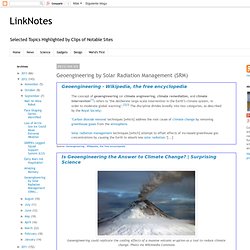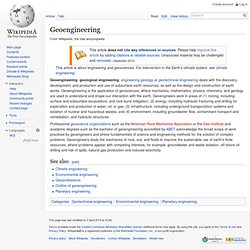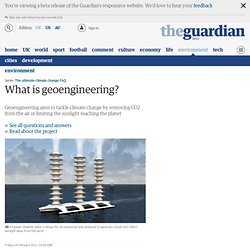

Geoengineering by Solar Radiation Management (SRM) Is Geoengineering the Answer to Climate Change?

| Surprising Science Geoengineering could replicate the cooling effects of a massive volcanic eruption as a tool to reduce climate change. Photo via Wikimedia Commons One proposed experiment would have used a balloon-tethered pipe to pump sulfur aerosols into the stratosphere and block a portion of solar radiation from reaching earth. Image via Wikimedia Commons/Hugh Hunt Now, for the first time, a team of scientists has specifically analyzed the immediate financial costs of employing such a technique. Delivering solar geoengineering materials may be feasible and affordable. Geoengineering. Geoengineering, geological engineering, engineering geology or geotechnical engineering deals with the discovery, development, and production and use of subsurface earth resources, as well as the design and construction of earth works.

Geoengineering is the application of geosciences, where mechanics, mathematics, physics, chemistry, and geology are used to understand and shape our interaction with the earth. Geoengineers work in areas of (1) mining, including surface and subsurface excavations, and rock burst mitigation; (2) energy, including hydraulic fracturing and drilling for exploration and production of water, oil, or gas; (3) infrastructure, including underground transportation systems and isolation of nuclear and hazardous wastes; and (4) environment, including groundwater flow, contaminant transport and remediation, and hydraulic structures. What is geoengineering? Geoengineering schemes are projects designed to tackle the effects of climate change directly, usually by removing CO2 from the air or limiting the amount of sunlight reaching the planet's surface.

Although large-scale geoengineering is still at the concept stage, advocates claim that it may eventually become essential if the world wants to avoid the worst effects of climate change. Critics, by contrast, claim that geoengineering isn't realistic – and may be a distraction from reducing emissions. The first category of scheme – those designed to remove CO2 from the air – include machines (sometimes called "artificial trees") that pull the gas from the atmosphere using plastic polymers. Other proposals seek to increase the amount of CO2 absorbed by the oceans – for example by adding large quantities of lime to the water. Other related schemes – sometimes but not always described as geo-engineering – involve harnessing the capacity of trees and plants to absorb CO2 from the air.
Is Geoengineering the Answer to Climate Change?
Geoengineering. US answer to global warming: smoke and giant space mirrors. Smog above Phoenix, Arizona US report suggests reflective dust could reduce warming.

Photograph: Deirdre Hamill/AP The US government wants the world's scientists to develop technology to block sunlight as a last-ditch way to halt global warming, the Guardian has learned. It says research into techniques such as giant mirrors in space or reflective dust pumped into the atmosphere would be "important insurance" against rising emissions, and has lobbied for such a strategy to be recommended by a major UN report on climate change, the first part of which will be published on Friday.
The US has also attempted to steer the UN report, prepared by the Intergovernmental Panel on Climate Change (IPCC), away from conclusions that would support a new worldwide climate treaty based on binding targets to reduce emissions - as sought by Tony Blair. The IPCC report is made up of three sections. Geoengineering projects around the world - map. Dumping iron at sea can bury carbon for centuries, study shows. Dumping iron into the sea can bury carbon dioxide for centuries, potentially helping reduce the impact of climate change, according to a major new study.

The work shows for the first time that much of the algae that blooms when iron filings are added dies and falls into the deep ocean. Geoengineering – technologies aimed at alleviating global warming – are controversial, with critics warning of unintended environmental side effects or encouraging complacency in global deals to cut carbon emissions. But Prof Victor Smetacek, at the Alfred Wegener Institute for Polar and Marine Research in Germany, who led the new research, said: "The time has come to differentiate: some geoengineering techniques are more dangerous than others. Doing nothing is probably the worst option. " Dave Reay, senior lecturer in carbon management at the University of Edinburgh, said: "This represents a whole new ball game in terms of iron fertilisation as a geoengineering technique.